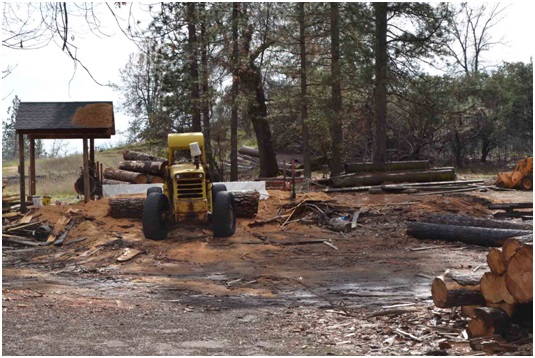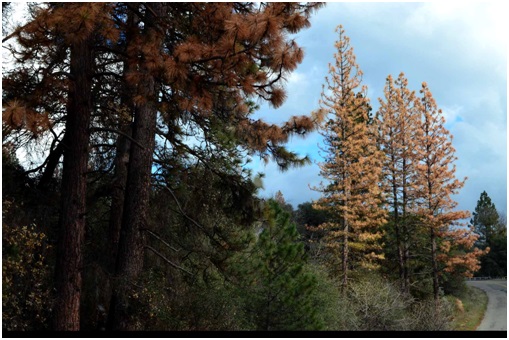With estimates of a 40 percent die-off of Ponderosa Pine this year, and dead and dying trees dotting the landscape in the mountain area, Cal Fire is offering some important assistance for homeowners.
The oncoming fire season, which is forecast to be even more volatile than 2014, makes it critical that diseased, dead and dying trees be removed as soon as possible.
Len Nielson, Unit Forester for Cal Fire in the Madera/Mariposa/Merced Unit, says both Madera and Mariposa Counties have infested areas due to the large number of trees, already stressed from over four years of drought, being killed by attacks from the Western Pine Beetle, the IPS Beetle and the Red Turpentine Beetle.
The prognosis for the rest of the year is rainfall at or below normal, which will only exacerbate an already deadly combination of conditions. In order to mitigate the danger posed by wildfire, homeowners have three options for Exemptions to get dangerous trees removed from their property while avoiding red tape and saving money.
The first option is for properties with a significant number of trees that pose a fire danger.
“If a landowner has lots of dead and dying trees, they can hire a Registered Professional Forester (RPF) to come out and do what is called a NOTICE OF EMERGENCY TIMBER OPERATIONS,” says Nielson. “This is to recover some of the value of the wood, which is going to be greatly depreciated unless it’s harvested quickly.”
Generally, when a landowner wants to harvest a significant amount of trees, they would have to go through the process of paying for and preparing a full Timber Harvest Plan, which can run many thousands of dollars and require a study and adherence to the California Environmental Quality Act (CEQA).
With an Exemption, landowners can streamline the CEQA evaluation, speed up the process, and get the permit for free. Their only expense would be the fee for the RPF, who will come out and review the area, look at the trees that are dead and dying, and identify those trees to be harvested.
There has been some concern that there are no nearby mills to take the trees that are being removed.
 “Timber companies are still taking the logs, though it is at a reduced price,” says Nielson. “That’s because of supply and demand. There’s a lot of supply right now, due to incidents such as the Rim Fire and the French Fire, so unfortunately for the landowner, log prices are low. However, the big bang for the buck here is to get the permit for free and streamline the process.”
“Timber companies are still taking the logs, though it is at a reduced price,” says Nielson. “That’s because of supply and demand. There’s a lot of supply right now, due to incidents such as the Rim Fire and the French Fire, so unfortunately for the landowner, log prices are low. However, the big bang for the buck here is to get the permit for free and streamline the process.”
The bottom line, says Nielson, is to get those dead trees off your property.
“By doing that, you reduce the fire load around your own property, and it’s less of a threat to you and your neighbors. Ultimately, in the event of a fire, these dead trees are going to torch very quickly, flinging embers into the air, and every one of them has a chance to start a fire. So when you reduce the dead trees, you increase the likelihood that your home will survive.”
Firewise Madera County and ReadyForWildfire.org have a wealth of information on preparing your home and your family for wildfire season.
Another Exemption is the “less than 10 percent” situation, called the CHRISTMAS TREE; DEAD, DYING OR DISEASED; FUELWOOD OR SPLIT PRODUCTS EXEMPTION. If less than 10 percent of the trees, per acre, on your property are dead or dying and need to be removed, you can call in a Licensed Timber Operator (LTO), who will write up and file the two-page permit, remove the designated trees, and deliver them to the mill for sale.
If you have less than 10 percent dead trees per acre on your property, you don’t need to call in a Registered Professional Forester, but can have a Licensed Timber Operator remove what is obviously dead or dying. However, if there’s a dead tree on your property, it is likely that the one next to it is probably dead too, but it “just doesn’t know it yet,” says Nielson.
“A Forester has the ability to go out and see if that tree will probably be dead next year, and you can take that one too. An LTO is not able to determine that. They can only remove what is obviously dead or dying.” And since a tree that looks healthy to an untrained eye may be infested with beetles, you may be ahead of the game to call for a professional opinion.
Nielson says it is always the best course of action to have trees removed by a licensed and insured professional like an LTO, rather than doing it yourself. Some trees near homes can be very technical to fall.
“Ultimately the landowner is responsible, because it’s the landowner that owns the tree,” says Nielson, noting that the responsible party is the one who gets the fine if things aren’t done correctly.
“The Licensed Timber Operator is more qualified and experienced in taking down trees. I would highly encourage that the LTO get the permit, because once a permit is filed, the LTO is responsible to do a good job. We have minimum standards with the State, and there are requirements that are associated with the permit. If you just hired Joe Anybody and they come to cut down your tree, and they leave a big mess in your yard, you may end up with more of a problem than a standing dead tree.”
With a permit in place, a landowner can call Nielson’s office in the event the work is not done properly, and it is then his job to come out and require the LTO to complete the job according to standards, or face violations.
Another Exemption is for a dead or dying tree within 150 feet of the home – REMOVAL OF FIRE HAZARD TREES WITHIN 150 FEET OF A STRUCTURE EXEMPTION. These trees can also be legally removed, and do not require the services of a Registered Professional Forester. A Licensed Timber Operator can take down an obviously dead or diseased tree.
Cal Fire Battalion Chief Chris Christopherson says he cannot emphasize enough how important it is to clear these trees now, create defensible space and harden your home against wildfire.
“We may look at the grass crop this year as being low to moderate because we haven’t had a significant amount of rainfall,” says Christopherson. “But when the grasses start to die and seed out, and we get another rain, then we get another thick layer of grass. Now you have two layers which makes it more heavily matted and increases the BTUs when it does burn, generating fires with more intensity and increasing flame lengths.”
That’s why it is so important to get trees limbed up and eliminate the ladder fuels, such as hanging branches and tall brush – thereby removing a path for the fire to travel from the ground up into the crowns of trees which are already distressed.
“This is something the homeowner can control – get rid of the ladder fuels,” says Christopherson.
With the continuing drought, the moisture levels in the fuels don’t have a chance to recover with so little precipitation over the winter months.
“When fuel moistures don’t have a chance to replenish themselves, instead of starting with 100 percent moisture capacity in the spring, we’re starting at 90 percent,” says Nielson. “Then another year of drought, and we’re starting at 80 percent. It’s a cumulative effect.”
Nielson says there were over 1,000 fires above the normal number in the state last year.
“For example, a car has a bad catalytic fuel converter, and part of it goes into the grass when it blows out. It may not normally start a fire because the fuel moisture is too high. Now, these have a higher chance of igniting fires. A chain dragging down the highway sparks into the grass. This year those have a potential to start fires because the fuel moistures are lower and it spreads faster.”
Nielson encourages homeowners to burn early and often. With the number of burn days seeming few and far between this year, it’s even more important to make sure you have your trimming work done and your piles ready to go, so that when there is a burn day in your area, you can safely fire off your piles. As the fire season comes on, you may run up against a burn ban once conditions become too dangerous for hazard debris burning.
You must have a burn permit to do hazard reduction burning, and they are available free of charge at any fire station. Follow the instructions on the permit, and call 1-877-429-2876 to find out if it is a burn day in your area. Information is updated after 4 p.m. for the next day’s burn status.
If you take down an infested tree and can’t burn it, you’ll want to tarp the debris with clear plastic in order to “compost” it, create heat and kill the bugs. To keep the bugs from escaping the tarp, you will need to dig down a bit around the edges to secure the tarp in the ground to make sure the critters are contained.
Homeowners also need to be aware that they can use their timber for their own private use – for firewood or milled into boards, for example – but if they sell, trade or barter it away, that requires a permit, because it now becomes a wood product. The timber owner is not allowed to trade services for the wood product.
If the public has questions about these Exemptions, they can call their Unit Forester, Len Nielson, at the Cal Fire Mariposa Headquarters at 209-966-3622.
There is also a wealth of information on the Cal Fire and Firewise websites:
For information on exemptions and the forms required, click here – www.calfire.ca.gov/resource_mgt/resource_mgt_forestpractice_harvestingforms.php
For the form required for removal of dead and dying trees by a Licenced Timber Operator, click here – http://calfire.ca.gov/resource_mgt/downloads/RM-73_ForestFirePreventionExemptionForm_12-08.pdf
For the form required for emergency exemption by Registered Professional Forester, click here – http://calfire.ca.gov/resource_mgt/downloads/RM-73_ForestFirePreventionExemptionForm_12-08.pdf
For more information about Licensed Timber Operators, click here – http://calfire.ca.gov/resource_mgt/resource_mgt_forestpractice_ltos.php
For a list of Licensed Timber Operators in California, click here – http://calfire.ca.gov/resource_mgt/downloads/LTO/Valid_LTO_List.pdf
For more information about Registered Professional Foresters, click here – http://www.bof.fire.ca.gov/professional_foresters_registration/locate_a_rpf_or_crm_/
For a list of Registered Professional Foresters in California, click here – http://www.bof.fire.ca.gov/professional_foresters_registration/how_to_locate_an_rpf_or_crm_search_engine/roster_of_rpfs/rpf_public_list_-_1.15.15.pdf
For more information on bark beetles in California conifers, click here – http://www.fs.usda.gov/Internet/FSE_DOCUMENTS/stelprd3818829.pdf
For information about hardening your home against wildfire, visit http://www.firewise.org/ or http://firewisemaderacounty.org/
For information about preparing your family for wildfire season, visit http://www.readyforwildfire.org/




